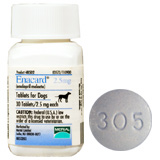Enacard Pet Medication

- Dog
- Availability: Prescription
- Active Ingredient(s):
- What is Enacard used for?
Enalapril is an angiotensin-converting-enzyme (ACE) inhibitor. It is used as a vasodilator in the treatment of heart failure, cardiomyopathy and high blood pressure.
- How Enacard should be used?
Enalapril is FDA approved for use in dogs only; however, it is a commonly accepted practice for veterinarians to use this medication in cats as well. The usual dose in dogs is 0.25mg/pound once a day. The usual dose in cats is 0.1-0.25mg/pound once a day. This medication is usually administered with digoxin and/or a diuretic such as furosemide. The dose of enalapril may require adjustment based on the patients response to treatment. It can be expected that treatment with enalapril will be for the life of the pet.
- What are the side effects?
The side effects of enalapril may include low blood pressure, loss of appetite, vomiting, diarrhea and kidney problems.
- What special precautions are there?
This medication should not be used in animals allergic to it or other ACE inhibitors. A complete physical exam should be performed prior to initiating therapy with enalapril. Kidney function should be retested within one week after starting the medication. Do not use in pregnant or nursing animals. Use caution when administering with diuretics such as furosemide or HCTZ. Enalapril may increase levels of potassium. NSAIDS such as aspirin and Rimadyl or COX-2 inhibitors such as Deramaxx may reduce the effectiveness of enalapril. Use with caution when given with Insulin, probenecid and potassium salts. Always tell your veterinarian and pharmacist what other medications your pet is taking.
- In the event of overdose?
Contact your veterinarian or veterinary emergency room. Symptoms of overdose may include low blood pressure, weakness, kidney failure, drowsiness or depression.
- How should I store Enacard?
Keep this medication in the container it came in, tightly closed. Store tablets at room temperature, away from excess heat, light and moisture. Do not store in the bathroom. Throw away any medication that is outdated or no longer needed. Keep medication away from children and pets.
Disclaimer: The information on this site is for educational purposes only and should NOT be considered veterinary advice. Any veterinary questions should be referred to your veterinarian. This information is NOT to be used for diagnosis or treatment of your pet. Please make your own inquiries with your veterinarian for the suitability of a product for your pet.




